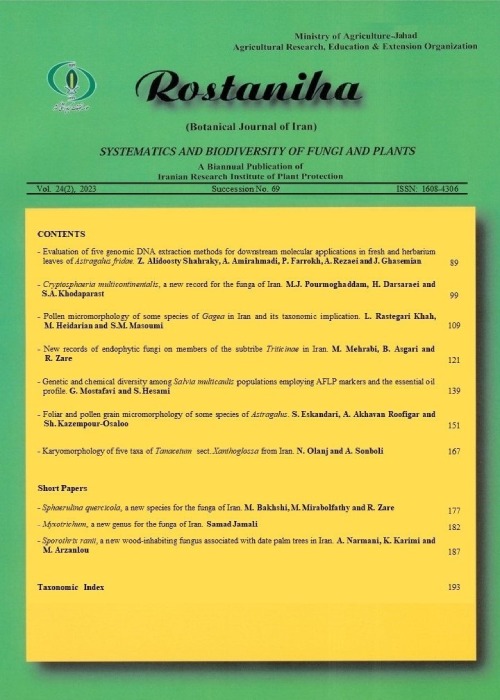First report of Ascotricha chartarum for funga of Iran
Abbas Abad travertine stone is one of the widely used travertine stones in Iran. The mines of this stone are located in Mahallat (Markazi province). By visitings various building stone sites of Shiraz (Fars province) in 2021, loose and rotten stones with black streaks were observed from which rocks were cracked (Fig. 1). Among the isolated fungi, one isolate was identified as Ascotricha chartarum Berk. based on morphological features and sequences data. Colonies slow-growing, having a diameter of 10 and 8 mm in seven days on PDA and MEA (Merck, Darmstadt, Germany), respectively; first dull white, then becoming black with an orange edge. Perithecia dark brown to black, globose or subglobose, 95–210 × 70–100 μm, ostiolate, with distinct, short cylindrical neck, 5–6.5 µm diam. Ascomatal hairs erect, rigid, dichotomously branched, geniculate, dark brown to black, septate, 3.9–5.5 µm at the base, with thin-walled vesicles at geniculate nodes. Asci cylindrical, thin-walled, evanescent, 8-spored, and 65–70 × 8–11 μm; Ascospores uniseriate, dark olive-brown to black when mature, ellipsoidal, smooth, discoid with a distinct equatorial slit, 6.5–9.2 × 6–8.2. Conidiophores in asexual morph (Dicyma ampullifera Boul.) straight, stiff, smooth or slightly roughened, simple or dichotomously branched, septate, brown to black below, becoming pale brown or hyaline above, up to 2 mm long, 3.5–5.5 μm diam., with pale, thin-walled vesicles at the bends, resembling the ascomatal hairs. Conidiogenous cells lateral and terminal, cylindrical, sympodial, developing conidia on denticles. Conidia lightly rough, irregularly globose to ellipsoidal, hyaline when young, becoming light brown at maturity, 4.7–6.4 × 2.2–3.8 μm. The sequence generated in this study was deposited in GenBank under accession No.: MW916314. BLAST analysis revealed a high nucleotide identity (99%) with the ITS region of A. chartarum (LS450963 and KF893284) which was recently reported from Kuwait and China, respectively. Ascotricha chartarum is new to the Iranian mycobiota, and is reported for the first time from building stones in the world.
- حق عضویت دریافتی صرف حمایت از نشریات عضو و نگهداری، تکمیل و توسعه مگیران میشود.
- پرداخت حق اشتراک و دانلود مقالات اجازه بازنشر آن در سایر رسانههای چاپی و دیجیتال را به کاربر نمیدهد.



